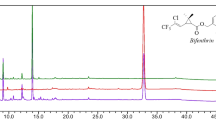Abstract.
A bacterium, identified as Brevibacterium sp. MM1, readily hydrolysed fenamiphos, a widely used organophosphorus insecticide and its toxic oxides (fenamiphos sulfoxide, fenamiphos sulfone), which all contain a common P–O–C bond, in a mineral salts medium. The bacterium also hydrolysed fenamiphos and its oxides in soil and groundwater. Interestingly, fenamiphos phenol, fenamiphos sulfoxide phenol and fenamiphos sulfone phenol, formed during bacterial hydrolysis of fenamiphos and its oxides, persisted in the mineral salts medium, but were transitory in soil and groundwater due to their further metabolism by indigenous micro-organisms. The cell-free preparation (crude enzyme) of this bacterium was very effective in hydrolysing fenamiphos. This is the first report on exceptionally rapid hydrolysis of fenamiphos by a bacterium in pure cultures, soil and groundwater.




Similar content being viewed by others
References
Abril M A, Michan C, Timmis KN, Ramos JL (1989) Regulator and enzyme specificities of the Tol plasmid-encoded upper pathway for degradation of aromatic hydrocarbons and expansion of the substrate range of the pathway. J Bacteriol 171:6782–6790
Adhya TK, Barik S, Sethunathan N (1981) Hydrolysis of selected organophosphorus insecticides by two bacteria isolated from flooded soils. J Appl Bacteriol 50:167–172
Brown KA (1980) Phosphotriesterases of Flavobacterium sp. Soil Biol Biochem 12:105–112
Chung K-Y, Ou L-T (1996) Degradation of fenamiphos sulfoxide and fenamiphos sulfone in soil with a previous history of continuous applications of fenamiphos. Arch Environ Contam Toxicol 30:452–458
Davis R, Johnson AW, Wauchoe RO (1993) Accelerated degradation of fenamiphos and its metabolites in soil previously treated with fenamiphos. J Nematol 25:679–685
Dillon P, Toze S, Pavelic P, Ragusa S, Wright M, Peter P, Gerges N, Rinck-Pfeiffer S (1999) Storing recycled water in an aquifer at Bolivar: benefits and risks. Aust Water Wastewater Assoc J Water 26:21–29
Franzmann PD, Zappia LR, Tilbury AL, Patterson BM, Davis GB, Mandelbaum RT (2000) Bioaugmentation of atrazine and fenamiphos impacted groundwater: laboratory evaluation. Bioremed J 4:237–248
Homeyer B (1971) Nemacur, a highly effective nematocide for protective and curative application. Pflanzenschutz-Nachr Bayer 24:48–68
Karpouzas DG, Morgan JAW, Walker A (2000) Isolation and characterisation of ethoprophos-degrading bacteria. FEMS Microbiol Ecol 33:209–218
Kookana RS, Phang C, Aylmore LAG (1997) Transformation and degradation of fenamiphos nematicide and its metabolites in soils. Aust J Soil Sci 35:753–761
Megharaj M, Singleton I, Kookana RS, Naidu R (1999) Persistence and effects of fenamiphos on native algal populations and enzyme activities in soil. Soil Biol Biochem 31:1549–1553
Mulbry WW, Karns JS (1989) Purification and characterization of three parathion hydrolases from Gram-negative bacterial strains. Appl Environ Microbiol 55:289–293
Ou LT (1991) Interactions of microorganisms and soil during fenamiphos degradation. Soil Sci Soc Am J 55:716–722
Ou LT, Rao PSC (1986) Degradation and metabolism of oxamyl and phenamiphos in soils. J Environ Sci Health B 21:25–40
Ou LT, Thomas JE (1994) Influence of soil organic matter and soil surfaces on a bacterial consortium that mineralizes fenamiphos. Soil Sci Soc Am J 58:1148–1153
Ou L-T, Thomas JE, Dickson DW (1994) Degradation of fenamiphos in soil with a history of continuous fenamiphos applications. Soil Sci Soc Am J 58:1139–1147
Sethunathan N, Pathak MD (1972) Increased biological hydrolysis of diazinon after repeated application in rice paddies. J Agric Food Chem 20:586–589
Sethunathan N, Yoshida T (1973) A Flavobacterium sp. that degrades diazinon and parathion as sole carbon sources. Can J Microbiol 19:873–875
Simon L, Spiteller M, Haisch A, Wallnöfer PR (1988) Abbau von fenamiphos in vier verschiedenen Bodentypen. Z Umweltchem Ökotoxikol 1:13–17
Simon L, Spiteller M, Haisch A, Wallnöfer PR (1992) Influence of soil properties on the degradation of the nematocide fenamiphos. Soil Biol Biochem 24:769–773
Zhongli C, Shunpeng L, Guoping F (2001) Isolation of methyl parathion-degrading strain M6 and cloning of the methyl parathion hydrolase gene. Appl Environ Microbiol 67:4922–4925
Acknowledgements.
We thank Dr. Z. Chen for help in HPLC analysis, Paul Pavelic for providing the groundwater samples and Dr. Brian Williams, University of Adelaide, for his critical comments. N.S. was supported by a BOYSCAST Fellowship, Government of India, New Delhi, India. Support from the Remediation of Contaminated Environments Program, CSIRO Land and Water, is acknowledged.
Author information
Authors and Affiliations
Corresponding author
Rights and permissions
About this article
Cite this article
Megharaj, M., Singh, N., Kookana, R.S. et al. Hydrolysis of fenamiphos and its oxidation products by a soil bacterium in pure culture, soil and water. Appl Microbiol Biotechnol 61, 252–256 (2003). https://doi.org/10.1007/s00253-002-1206-2
Received:
Revised:
Accepted:
Published:
Issue Date:
DOI: https://doi.org/10.1007/s00253-002-1206-2




